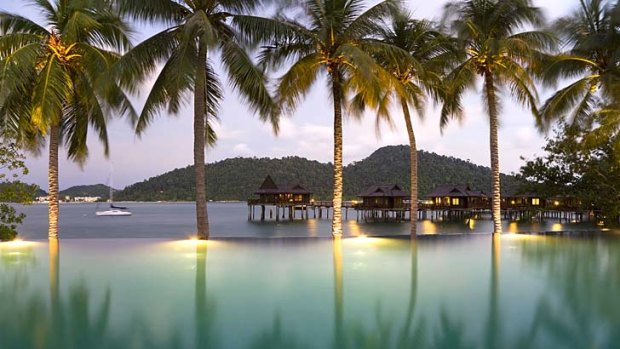
All spice... Pangkor Laut island.Credit: Getty Images
Katie Derham combines resort stays and beach days with cooking classes and sensory delights in Malaysia.
A hotel shows its character when the weather turns nasty. An unseasonably late and heavy monsoon in north-east Malaysia isn't just threatening the sense of humour of the guests, it's causing chaos locally, with flooding and storm damage.
But at Tanjong Jara, what I like to call the Kellerman spirit - in homage to the film Dirty Dancing - kicks in with grace and speed, and we are offered activities as diverse as batik painting and playing Chong Ka (a kind of hybrid of marbles and backgammon). For us, though, the choice is easy. We will learn to cook.
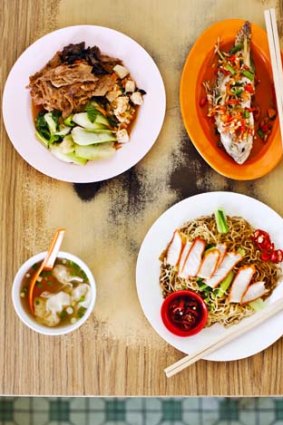
A selection of Malaysian dishes.Credit: Getty Images
Tanjong Jara is the start of a gastronomic journey around Malaysia that takes in the east and west coasts of the peninsula, as well as the capital, Kuala Lumpur. Before I go, I'm afraid my knowledge of the country is shamefully limited to geography lessons about the rubber industry. But as a family, we're crazy for Asian food, and the prospect of being taught how to wield a wok by the pros, with the added lure of time on the beach, is too good to pass up.
Malaysia is a perfect foodie destination. The cuisine of neighbouring Thailand may be better known but Malaysian cuisine is more complicated - and richer for it. The country was firmly on the spice route, and the original Malays were a seafaring bunch, so the food, as well as the culture, has long been influenced by the traders - and invaders - of the region.
For hundreds of years there were strong links with India. More recently, thousands of Indians have been brought in to work on the rubber plantations. There's a large Chinese population, too, so in the west and in the capital, menus include curries as well as Thai-style stir-fries and Chinese noodles.
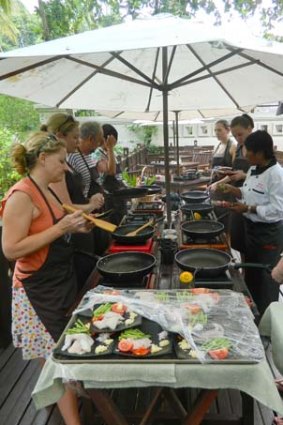
Cooking at Tanjong Jara market.
Beef rendang is virtually the Malaysian national dish and has to be tried, but what tickles us most is that Malaysia invented satay. It's cooked on every street corner, on a charcoal griddle, with ladles of freshly made peanut sauce.
Our culinary education starts with a trip to Tanjong Jara's nearest local market. In the care of a talented, eccentric and hilarious chef called Ann, we make our way along a neat, palm-lined coastal road, to the covered market in the town of Dungun. It seems a crime to leave the comfort of Tanjong Jara, but any hankering for the resort is soon forgotten as we wander, wide-eyed, past stalls piled with herbs and vegetables, and fish vendors determined to make the children jump by waving enormous mackerel and ugly monkfish at them. Ann tells me which spices she couldn't live without. Garlic and chilli come as no surprise. But galangal? It looks like a ginger root but is citrusy and a staple of her noodle dishes. Then there's a fermented shrimp paste called belacan, which smells like nothing on Earth before it's cooked, but adds a non-fishy sweetness and intensity to meat.
"I'm tired, let's have a cappuccino," Ann says, and we look blankly for a coffee shop in the heaving market. Cappuccino, it transpires, means a stall where instant coffee and warm condensed milk is poured - or pulled, as they say - back and forth between two mugs until it develops a good froth. Not bad, actually.
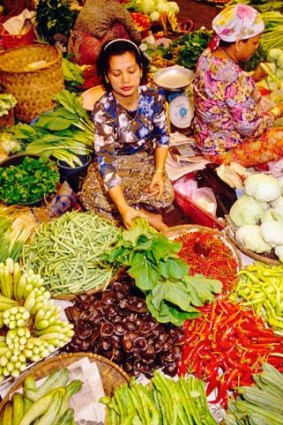
A local produce market.Credit: Alamy
Two hours later we've cooked much of what we've bought: buttermilk prawns, with an indulgent cream and chilli sauce topped with crispy deep-fried egg yolk (very fiddly); spicy chicken noodles, mamak-style; and beef with lemongrass and coconut milk. It all looks a bit haphazard and I'm still not sure we should have let five-year-old Eleanor chop chillies with an eight-inch blade, but the pride and effort involved makes it the best lunch we've eaten.
With more time, we could travel slowly through the west coast to the tea plantations and nature reserves of the Cameron Highlands, where the British empire still lingers in the names of the bungalows and the air is cool. We drive on good roads, passing precisely planted plantations. Palm oil has mostly replaced rubber these days. It's fascinating to see the freshly painted gates and signs with the names of international conglomerates cheek by jowl with traditional wooden homes on stilts. It's slightly worrying to realise, after the first hour or so, that all this used to be virgin jungle. Still, on to the ferry, relishing the fact that the monsoon on this side of the peninsula has finished, and we are off to the island of Pangkor Laut. It has the perfect palm-fringed beach; picturesque cabins on stilts in the sea, with terraces from which you gaze at the glorious sunset or deep into each other's eyes. It also has a fine spa, restaurants, and gorgeous views of ancient rainforest to feast upon if you'd rather lie still in a hammock.
Just to add to the package, a chef can come to your cabin and cook just about anything. We're on a mission to eat our way around Malaysia, and now we discover we can do so without moving a muscle. I have handwritten recipes of some of the dozens of dishes we've worked our way through - all for research, of course. Some we were allowed to watch being prepared - the pad thai, the black-bean beef, the sweet-and-sour grouper. There was also a Chinese cooking class where we made spring rolls and chilli sauce, learnt how to steam sea bass perfectly (easier when you have an industrial-size bamboo steamer) and made chilled honeydew with tapioca pearl, which the children found delicious once they stopped saying "urgh, it looks like frogspawn".
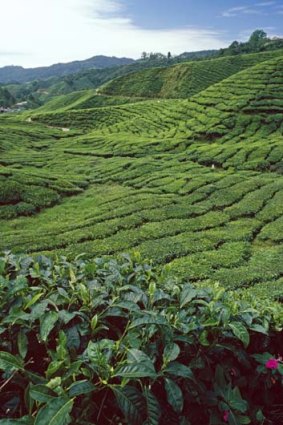
A tea plantation on the Cameron Highlands.Credit: Getty Images
Then to Kuala Lumpur where, happily, street food's alive and well, and though it might seem counter-intuitive, there are wonderful restaurants tucked into the ubiquitous shopping malls. We find a kind of fantasy food court called Feast in the basement of the Starhill mall, next door to the Ritz-Carlton hotel. The imagination of its decor is matched by the variety and quality of the food on offer. So good, in fact, that it seems churlish to try our new-found cooking skills. Sometimes you're better off leaving it to the experts.
FAST FACTS
Getting there
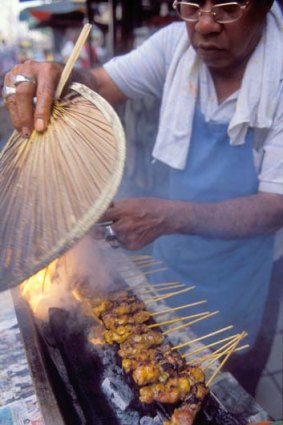
A satay stall in Kuala Lumpur.Credit: Alamy
Malaysia Airlines has a fare to Kuala Terengganu from Sydney and Melbourne for about $1280 low-season return including tax. Fly to Kuala Lumpur (about 8hr), then to Kuala Terengganu (1hr). See malaysiaairlines.com.
Staying there
Tanjong Jara Resort is a 99-room stay on the east coast facing the South China Sea, about a one-hour drive from Kuala Terengganu Airport. Rooms from 750 ringgit ($228) a night for two people. Chef Ann is available by appointment at the resort. See tanjongjararesort.com.
Pangkor Laut Resort is on the privately owned island of Pangkor Laut, along the Straits of Malacca off Malaysia's west coast, accessible from Kuala Lumpur by road to Marina Island Pangkor followed by a 15-minute boat ride. The resort has 140 villas costing from 760 ringgit a night for two people, and a chef's kitchen experience, which includes a cooking class and visiting a fish farm. See pangkorlautresort.com.
Touring there
Abercrombie & Kent arranges stays at both resorts, with transfers between the east and west coasts. See abercrombiekent.com.au.
While there
Tenggol Island, part of the Terengganu Marine Park, has untouched coral gardens and rare marine life and is a 45-minute speedboat ride from Tanjong Jara. Experienced dive instructors accompany resort guests to dive spots.
When to go
The east coast monsoon season is usually from November-February; the west coast from October-November and April-May.
More information
See tourism.gov.my.
Sizzle in the city
Enak KL is a contemporary restaurant serving "fine-dining" traditional cuisine in the capital. Sample classic regional dishes such as padang rendang and sambal prawns. Reservations are essential. LG2, Feast Floor, Starhill Gallery. See enakkl.com.
Popular with the locals, Hakka Republic is a slick restaurant and bar whose interiors and cuisine are a well-executed fusion of Western and Japanese influences. Warm corn breads precede miso foie gras, and Australian wagyu rib-eye steak is served with truffle polenta and Japanese pickled vegetables. Level 2, Menara Hap Seng, Jalan P Ramlee. See hakkarepublic.com.
Sip a Selangor Sling cocktail at SkyBar on the 33rd floor of the Traders Hotel. The views are unbeatable. See shangri-la.com.
Kuala Lumpur has several impressive parks, which provide welcome breaks from the city's skyscrapers. However, to make a complete escape from KL's urban clamour, take a train to nearby Putrajaya and explore the extensive Floral Gardens. See ppj.gov.my.
KL's Islamic Arts Museum has fascinating exhibitions that bring the cultural heritage of Malaysia alive and chronicle the history and evolution of its indigenous and other peoples. Jalan Lembah Perdana, 50480. See iamm.org.my.
Haggling is expected in Chinatown. Visit the night market on Petaling Street (also known as Chee Cheong Kai, meaning starch factory street, in reference to its roots as a tapioca-producing district) for herbs, fresh curry, noodles and imitation goods.
- Telegraph, London
Sign up for the Traveller Deals newsletter
Get exclusive travel deals delivered straight to your inbox. Sign up now.